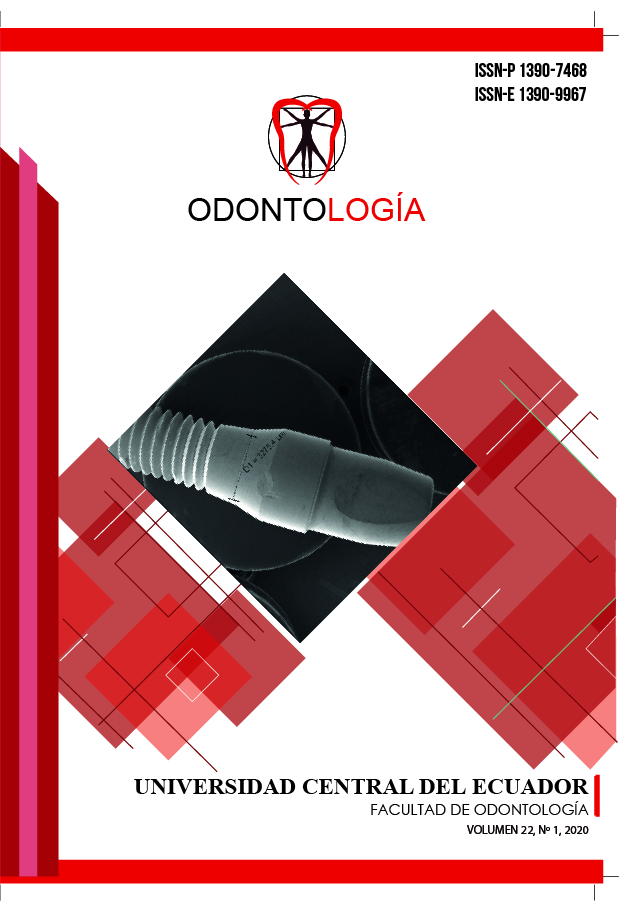Microfiltración marginal en cavidades clase II restauradas con resinas nano híbridas vs resinas nano hibridas bulk fill. Estudio in vitro
DOI:
https://doi.org/10.29166/odontologia.vol22.n1.2020-55-65Palabras clave:
Adaptación Marginal, Resinas Compuestas, Materiales Dentale, Fracaso de la Restauración, Filtración DentalResumen
Entre las complicaciones posoperatorias, es frecuente la microfiltración cuando se realizan restauraciones directas con resina en el sector posterior, sobre todo en la parte profunda de las cajas proximales. Objetivo: Evaluar por medio de un estéreo microscopio si resinas nano híbridas Bulk Fill presentan menor grado de microfiltración marginal en cavidades clase II que resinas nano híbridas convencionales. Materiales y métodos: Cavidades estandarizadas clase II de Black de 30 premolares extraídos por indicación ortodóntica fueron restauradas aleatoriamente en dos grupos (n= 15). El primer grupo fue restaurado con resina nano híbrida Tetric EvoCeram® (Ivoclar) con incrementos de 2mm y el segundo grupo con resina nano híbridas Bulk Fill (ivoclar) con incrementos de 4 mm. Todas las muestras fueron sometidas a termociclado durante 5000 ciclos y posteriormente fueron sumergidas en azul de metileno durante 24 horas. Finalmente, se realizó un corte sagital de manera uniforme y se evaluó la profundidad de la microfiltración marginal en la base de la caja proximal por medio de un estéreo microscopio y el análisis de dos observadores ciegos. Resultados: Los dos grupos presentaron microfiltración marginal, en distintos grados. Conclusión: aunque las cavidades restauradas con resina nano híbridas Bulk Fill presentaron valores menores, la prueba de Mann Whitney dio como resultado que las diferencias existentes no son estadísticamente significativas (p = 0,181).
Descargas
Citas
Zeballos L., Pérez Álvaro. Materiales Dentales De Restauración. Revista de Actualización Clínica. 2013; (30): 1498-1504.
Lois M., Paz R., & Pazos S. Estudio in vitro de microfiltración en obturaciones de clase II de resina compuesta condensable. Av. Odontoestomatol. 2004; 20 (2): 85-94.
Ramírez R. A., Setién V., Orellana N., & García C. Microfiltración en cavidades clase II restauradas con resinas compuestas de baja contracción. Acta Odontológica Venezolana. 2009; 47(1): 131-139
Mahn E. Cambiando el paradigma de la aplicación de composites: Tetric Evoceram® Bulk Fill. Ivoclar Vivadent - Special Edition, 1-24.
Domínguez Burich R. Análisis comparativo in vitro del grado de sellado marginal de restauraciones de resina compuesta realizadas con un material monoincremental (TETRIC N-CERAM BULK FILL), Y UNO CONVENCIONAL TETRIC N-CERAM)". Tesis. Santiago De Chile: Universidad De Chile, Facultad De Odontología; 2014
Nocchi, E. Odontología restauradora. Salud y estética. 2ª ed., Buenos Aires: Editorial Médica Panamericana; 2008. p.2-5.
Uehara N., Ruiz A., Velasco J. Adaptación Marginal De Las Resinas Bulk Fill. Marginal Adaptation Of Bulk Fill Resin. RODYB. 2013; 2(3); 1-10
Rosas B., Soto V., Ruiz P., Estabilidad marginal de una resina condensable versus resina monoincremental activada sónicamente en restauraciones clase II: Estudio in vitro. Av. Odontoestomatol. 2016; 32(1): 45-53
Pachecho C., Gehrkue A., Aragonés P. Evaluación de la adaptación interna de resinas compuestas: Técnica incremental versus bulk-fill con activación sónica. Av. Odontoestomatol. 2015; 31(5): 313-321.
Alves, E., Ardu, S., Lefever, D., & Jasse, F. F. ScienceDirect Marginal adaptation of class II cavities restored with bulk-fill composites. J Dent. 2014; 42(5): 575-581
Lally U. Restoring class II cavities with composite resin, utilising the bulk filling technique. J Ir Dental Ass 2014:60(2):74-76
Furness A, Tadros MY, Looney SW, Rueggeberg FA. Effect of bulk/incremental fill on internal gap formation of bulk-fill composites. J Dent 2014; 42(4): 439-449.
Hilton T. Schwartz RS, Ferrancane JL. Microleakage of four Class II resin composite insertion techniques at intraoral temperature. Quintessence Int, 1997; 28(2); 135-144.
Gallo JR, Bates ML, Burgess JO. Microleakage and adaptation of class II packable resin-based composites using incremental or bulk filling techniques. Am J Dent 2000;13(2): 205-208.
Alshali RZ, Salim NA, Satterthwaite JD, Silikas N. Post-irradiation hardness development, chemical softening, and thermal stability of bulk-fill and conventional resin-composites. J Dent 2015;43 (2):209-18.
Heintze SD, Monreal D, Peschke A. Marginal Quality of Class II Composite Restorations Placed in Bulk Compared to an Incremental Technique: Evaluation with SEM and Stereomicroscope. J Adhes Dent 2015;17(2):147-54.
El-Damanhoury H, Platt J. Polymerization shrinkage stress kinetics and related properties of bulk-fill resin composites. Oper Dent. 2014;39(4):374-82.
Nagi SM, Moharam LM, Zaazou MH. Effect of resin thickness, and curing time on the micro-hardness of bulk-fill resin composites. J Clin Exp Dent. 2015;7(5):e600-4.
Orłowski M, Tarczydło B, Chałas R. Evaluation of Marginal Integrity of Four Bulk-Fill Dental Composite Materials: In Vitro Study. Sci World J 2015;2015:1-8.
Benetti A, Havndrup-Pedersen C, Honoré D, Pedersen M, Pallesen U. Bulk-Fill Resin Composites: Polymerization Contraction, Depth of Cure, and Gap Formation. Oper Dent 2015;40(2):190- 200.
Publicado
Cómo citar
Número
Sección
Licencia
Derechos de autor 2020 Paulina Alexandra Jinez Zuñiga, Iván Ricardo García Merino, Javier Oswaldo Silva Silva

Esta obra está bajo una licencia internacional Creative Commons Atribución-NoComercial-SinDerivadas 4.0.


